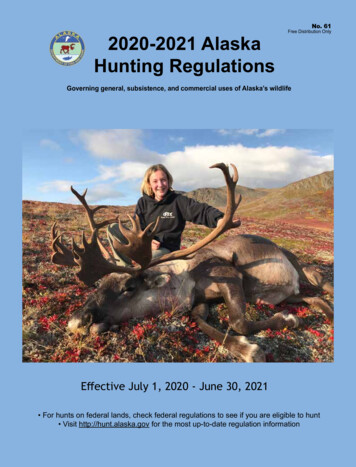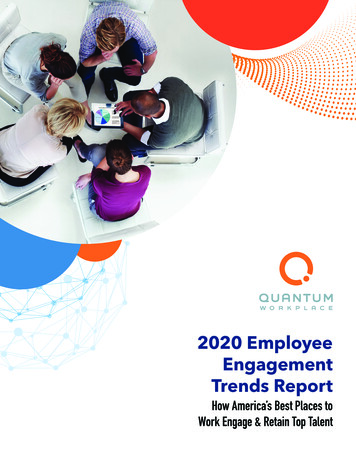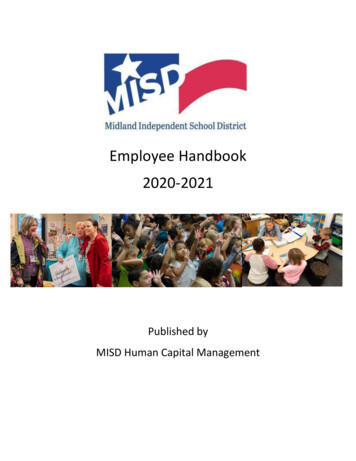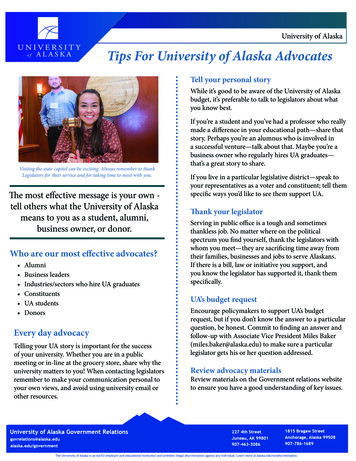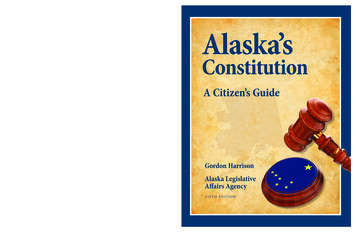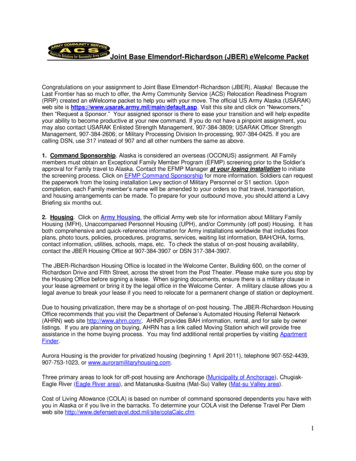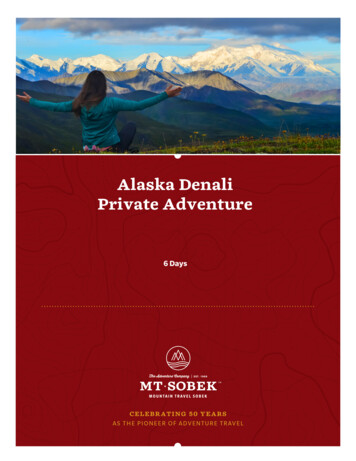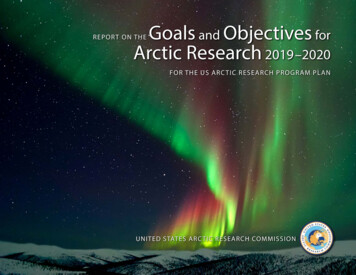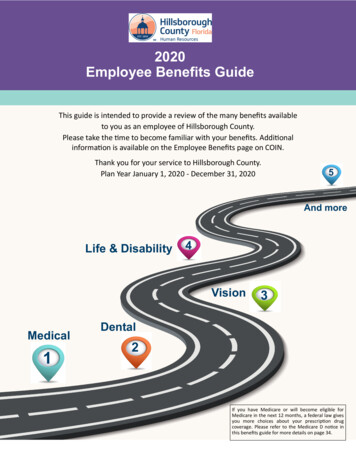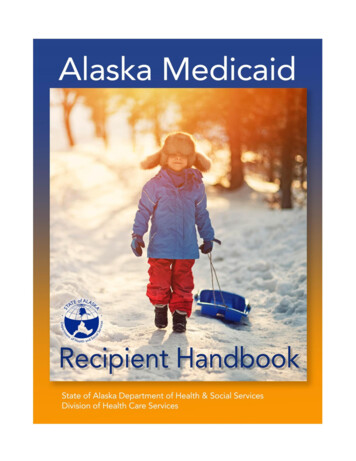
Transcription
EMPLOYEE HANDBOOKALASKA MARINE HIGHWAY SYSTEM2022www.FerryAlaska.com
Department of Transportation andPublic FacilitiesALASKA MARINE HIGHWAY SYSTEMOffice of the General Manager7037 North Tongass HighwayKetchikan, Alaska 99901-9101Main: 907.228.7250Fax: 907.228.6875Dear New Shipmates,The Alaska Marine Highway System operates the largest roll-on/roll-off, overnight capacity, passengervessel fleet in the United States. Our ships were designed and built specifically for service in Alaskanwaters, from the first ferries built in 1963 to the newest Alaska Class Ferries, bringing the total number ofAMHS vessels to ten.Whether operating throughout the Inside Passage of Southeast Alaska to Prince William Sound orthroughout the southwest region of the state to Unalaska, ships of the Alaska Marine Highway Systemprovide an essential transportation network serving residents and visitors alike, as stated in our missionstatement:"The mission of the Alaska Marine Highway System is to provide safe, reliable, and efficienttransportation of people, goods and vehicles among Alaskan communities and the "Lower 48", whileproviding opportunities to develop and maintain a reasonable standard of living and a high quality of life,including social, education, and health needs."The Alaska Marine Highway System has a long and proud tradition of providing safe, qualitytransportation andbeyond-the-call-of-duty customer service. This tradition has been forged through thediligent and committed service of all Alaska Marine Highway System employees, both afloat and ashore,for over fifty years. Your challenge is to follow the example of those who have gone before you and toperform your job to the best of your ability. Our customers and the state of Alaska deserve nothing lessthan your best effort!Sincerely,Captain John F. Falvey Jr.General ManagerJFF:vc“Keep Alaska Moving through service and infrastructure.”
New Employee HandbookTABLE OF CONTENTSWelcome Aboard 9Part of a Proud Fleet9System Overview9Uniquely Alaskan9The Organization10Deck Department10Engineering Department10Passenger Services Department10Shoreside Support and Administration11What to Expect from AMHS11Pay, Benefits and Work Environment11Union Support11Training and Career Development11Performance Evaluation12What we Expect from You12Overview12Mutual Respect13Policy Familiarization13General Appearance13Jewelry13Grooming13Uniform Specifications14General & Position Specific Requirements14Officer Stripes and Insignias16Required Documentation17Assignments & Scheduling19
Alaska Marine Highway SystemTABLE OF CONTENTSPreparation19Reporting to Work19Seasonal Relief Employees19Sample IBU Crew List20Unable to Report for Work21Boarding a Vessel21Life Onboard22Corrective Action22Important Policies to Know23Electronics and Cell Phone Use23Smoking23Americans with Disabilities Act23Drug Free Workplace23AMHS Drug and Alcohol Policy24Drug Test Responsibility Memo25Harassment Policy26Safety and Security27Accidents and Accident Reporting27Notice to AMHS Employees28AMHS Security Team29International Safety Management Code (ISM)29Designated Person Ashore (DPA)29Appendix I: Passenger Services New Hires30Appendix II: Deck & Engine New Hires36Appendix III: Computer Based Resources38Appendix IV: Entry Level Training & Certifications50Appendix V: Vessel Specifications54
New Employee HandbookHELPFUL ACRONYMSADAAmericans with Disabilities ActAMHSAlaska Marine Highway SystemBTBasic TrainingCBTComputer Based TrainingCFPMCertified Food Protection ManagerCFRCode of Federal RegulationsDERDOT & PFDPADesignated Employer RepresentativeDepartment of Transportation & Public FacilitiesEEODesignated Person AshoreEqual Employment OpportunityFRBFast Rescue BoatGMDSSGlobal Marine Distress & Safety SystemsHAZMATHazardous MaterialsHCTHazardous Communication TrainingISMInternational Safety ManagmentJCOJuneau Central OfficeKCOKetchikan Central OfficeLWOPLeave Without PayMEFMarine Engineering Facility (Ketchikan)MESMarine Evacuation SystemMMCMQMerchant Mariners CredentialMinimum QualificationsPAX ROROPassenger Roll On / Roll OffPSCProficiency in Survival CraftPSWPassenger Services WorkerPSWICSASOPPassenger Services Worker in ChargeSecurity AwarenessStandard Operating ProcedureSTCWStandard for Training, Certification and WatchkeepingTWICTransportation Worker Identification CredentialUSCGUnited States Coast GuardVPDSDVessel Personnel with Security Duties
New Employee HandbookWELCOME ABOARD!We are excited and proud to have you as a part of the Alaska Marine Highway System (AMHS). While you navigate thewaters of your new career, we hope that you take on the same pride and excitement in the system and yourself. The moreknowledge you have about your job and AMHS, the easier these days will be. Please begin by reading this handbookbefore you report for your first day of work. It is yours to keep and we encourage you to take personal notes to understandkey points or to keep track of questions you have that are not addressed within the handbook. We do not expect youto absorb all of this information at once, but it will begin to make more sense as you progress through training andorientation as well as begin your job.Part of a Proud FleetThe Alaska Marine Highway System was formerly founded in 1963, but the roots of the organization date back to 1948.It all started with three men and a dream, and has grown into a vast system that covers 3,500 miles of coastline, employshundreds of people and carries thousands of passengers and vehicles each year. Of the 10 AMHS vessels, 7 operatein the Southeast system and 3 operate in the Southwest / South Central system (please refer to Appendix V for morevessel details). All vessels are designed to carry passengers and vehicles ranging in size from motorcycles to large freightcontainer vans.The AMHS has scheduled stops in 35 ports starting in Bellingham, WA and Dutch Harbor, AK a distance comparable toa voyage from New York to London. The longest individual route within the system is from Bellingham to Kodiak, a tripthat takes approximately 6 days (one-way) and travels 1,698 nautical miles, which includes intermediate port stops inKetchikan, Juneau, and Whittier. The route from Homer to Dutch Harbor is approximately 900 miles in length, while theshortest route segment is 8 miles between Ketchikan and Annette Bay.System OverviewThe Southeast system is divided into two subsystems: the “mainline” routes which typically take more than one day for theship to travel; and shorter routes where the vessels depart their home port in the morning, travel to destination ports andthen return to their home port on the same day. The shorter routes are commonly referred to as “day boat” routes such asthe one to Annette Bay, served year-round by the MV Lituya. Service to the smaller Southeast communities as well as SouthCentral communities operate year-round with less frequent port calls during the winter.The Southwest and South Central systems serve Prince William Sound, Kodiak Island, the Kenai Peninsula, and theAleutian Islands. The communities on the Aleutian Chain receive one port call each month from April through Octoberand no service the remaining months. The Southeast and South Central regions are linked during the summer months,via Cross Gulf sailings from Juneau to Whittier via the MV Kennicott. Please review the route map on the back cover of thishandbook for a visual guide of the system.Uniquely AlaskanMost of the Alaska ports served by AMHS have populations of less than 5,000 people that use the ferries for opportunitiesto shop, conduct business and socialize with neighbors in other communities. The passenger base shifts from seasonto season with the addition of many visitors to the local traffic. Vehicles transporting freight and mail comprise some10 - 15% of the total vehicular traffic. Freight carriers, such as Lynden Transport, make up a large portion of this vehicletraffic with some individual businesses also transporting perishables. On average, AMHS carries 312,000 passengers and98,000 vehicles with two-thirds of the annual traffic riding from May to September.Passenger traffic is normally light and the pace more leisurely during fall, winter, and spring with a majority of communitiesbeing served with less frequency than during the summer. During this time of year, more than 10,000 students and youth9
Alaska Marine Highway Systemgroups travel to basketball tournaments, music festivals, wrestling and track meets, baseball games, foreign languagefestivals, and numerous other events. Special events also generate added passengers, such as the Gold Medal BasketballTournament held each spring in Juneau. During this event, ferries can be completely full, both coming and going, aspeople from the smaller communities gather in Juneau for the week. Without AMHS, these communities would otherwisebe cut off from the rest of the state and the “Lower 48”.THE ORGANIZATIONAMHS service helps to meet the social, educational, health and economic needs of Alaskans connecting communitieswith each other, regional centers, and the continental road system. Trips on AMHS can last several hours or several days,so most vessels provide food service, shower facilities, observation lounges, and recliner lounges. The larger vesselsprovide additional amenities, including play areas for children and stateroom accommodations for overnight travel, orfor passengers who want a space they can call their own while traveling. A vital transportation system of this size andcomplexity requires extensive shore side and onboard support to keep it operating. The organization and each vessel arebroken down into departments with a governing organizational structure within each department. The following is a briefdescription of what each general department covers, both onboard and onshore.Deck DepartmentThe Deck department leads the fleet with positions of command. AMHS Licensed Deck officers are either graduates ofone of several maritime academies or gain their knowledge, skills, and abilities through intensive self-study and on-thejob training. AMHS currently has approximately 105 deck officers navigating AMHS vessels, but not all deck crew arelicensed. Employees in unlicensed positions are able to perform almost any task in relation to deck maintenance, smallboat operations, basic navigation and seamanship. Licensed: Master, Chief Mate, Second Mate and Third MateUnlicensed: Bos’n, Able Bodied Seaman, Ordinary Seaman, Porter and WatchmenEngineering DepartmentThe Engineering department is responsible for maintaining all machinery in the main engine room, auxiliary engineroom, marine sanitation device (MSD) room, and the steering gear room, as well as maintaining the ship’s structuralintegrity. Employees in this department have job functions that include maintaining fluid levels, propulsion system andpower plants, all equipment and machinery, ordering & storing parts, and maintaining the safety & security of the vessel. Licensed: Chief Engineer, First Engineer, Second Engineer and Third EngineerUnlicensed: Junior Engineer, Oiler and WiperPassenger Services DepartmentThe Passenger Services department is the cornerstone of outstanding onboard customer service. This department isresponsible for services that include; maintaining all vessel amenities, on-board storage and distribution of provisions andsupplies, administering embarkation & disembarkation of passengers and vehicles, handling financial transactions andreporting, food and beverage service, medical assistance, stateroom sales and service, filing and reporting of regulatorypaperwork, and providing information services for both crew and passengers. This department encompasses bothSteward & Purser positions. Chief Purser, Senior Purser and Junior PurserChief Steward, Second Steward, Storekeeper, Chief Cook, Second CookHead Waiter, Head BR, Assistant Second Cook, Cashier, Mess StewardNight Utility, Dishwasher, Steward, Officer’s BR, Waiter10
New Employee HandbookShoreside Support and AdministrationShoreside Support and Administration consists of various departments. Each department provides all of the necessaryland-based support that is needed to keep the system running. Aside from Reservations located at the Juneau CentralOffice (JCO) and the Terminals that are located in port communities, most of these departments operate out of Ketchikanin either the Ketchikan Central Office (KCO) or the Marine Engineering Facility (MEF). Executive Management: Includes Executive Managment with ISMBusiness Development: Computer Services, Finance, Administration, Information Technology,Marketing, Reservations & Sales, Terminals and Terminal Services.Marine Engineering: Vessel Engineering and Marine FacilitiesMarine Operations: Passenger Services, Vessel Operations, Licensed & Unlicensed Dispatching, Training andVessel Scheduling, Security, Environmental Compliance and Safety.WHAT TO EXPECT FROM AMHSPay, Benefits and Work EnvironmentAMHS prides itself on offering fair wages and quality benefits. Pay is distributed bi-weekly and you should be sure to finalizeyour timesheet prior to leaving a vessel. A pay calendar (salary schedule) can be obtained from http://doa.alaska.gov/dof/payroll/ or through the link on the AMHS Internal Resources website. Benefits ranging from health care to employeediscounts can be found on the State Employee Resources page http://alaska.gov/employeeHome.html or through the linkon Internal Resources. Please refer to Appendix III in this handbook for more information on your username, employeeID and password, Internal Resources and how to access your pay stubs. Your SOA username, SOA Employee ID and SOApassword will be issued once you are in the payroll system and you will be responsible for maintaining your password.State of Alaska employee benefits, combined with a competitive yet safe working environment, offer a quality experiencewhen joining at any level of the organization.Union SupportAs an AMHS employee, you are represented by one of several unions. As a vessel employee, you are represented by oneof the maritime unions:1. Licensed Deck Personnel: Masters Mates and Pilots (MM&P)2. Licensed Engine Personnel: Marine Engineers Beneficial Association (MEBA)3. All Unlicensed Personnel: Inland Boatman’s Union of the Pacific (IBU)You may obtain a copy of the Collective Bargaining Agreement from your union or it is available at all times throughInternal Resources. Read it carefully and bring any questions or concerns that you have to your union representative. Thisdocument will give you complete details on matters of interest to you that include but are not limited to salary, benefits,premium pay, allowances, vacations and work hours.Training & Career DevelopmentAMHS has both in-house courses and courses contracted through maritime training providers to ensure that USCG approvedclasses are accessible to all crew members. Crew members must complete courses and obtain USCG documentation inorder to be eligible for dispatch to job assignments. In addition to these courses, there may be other training requirementsthat you will need to complete to maintain your position or advance. Once onboard a vessel, supervisory staff will providevessel orientation to all new employees as well as provide ongoing job related training.11
Alaska Marine Highway SystemAMHS policy states that position requirements are maintained in order to retain a position, but these requirements are alsoopportunities for growth and change through advancement. Career advancement opportunities exist at AMHS for thosewilling to work hard and take steps toward development. As you advance in your career, the qualifications you gain, howwell you perform on the job, and how long you’ve been with AMHS will all be considered when it comes to advancement.Each AMHS shipboard position has a set of “Minimum Qualifications” (MQ’s) that outline the specific requirements eachmariner must have completed to obtain a permanent or “bid” position. The MQ’s can be found on Internal Resources andthey will be a good resource for each mariner to see what courses they will need to complete to obtain a particular position.Training availability can also be found on Internal Resources to see when and where particular courses are offered. Pleasenote that although these courses may be job or career related they are often at the Mariner’s own expense.AMHS has specific requirements, mandated by law, for record-keeping both shipboard and on shore. Original recordsneed to be in your required 3-ring binder (please see below) when reporting for duty and copies must be maintainedon file at KCO. This is in addition to filing USCG approved course certificates within one year at your local USCG RegionalExam Center. Both electronic and hard copy files at KCO are central to the dispatching process and are used to evaluate bidapplications. It is the responsibility of each crew member to ensure all documents are properly in place. You may NOT benotified when documents on file expire but Compliance Lists are maintained on this website for your review at any time.All documentation can be submitted by e-mail to dot.amhs.crew.docs@alaska.gov (Preferred). Alternatively, you can useone of the following methods:1. US Mail to KCO: AMHS Training Dept. Attn: Crew Docs 7037 North Tongass Highway Ketchikan, AK 999012. Fax to KCO: AMHS Training Dept. Attn: Crew Docs (907) 228-68733. Interdepartmental Mail: See the Purser of Vessel for more informationPlease allow 5 business days from the date the documents are received at KCO either in hard copy or electronically forprocessing. If you feel it will impact your eligibility for dispatch, send a copy to your dispatcher.Performance EvaluationYour supervisor is aware that soon after you begin, you will want to know how you are doing. Depending on your particularposition, you will be given evaluations along the way. No matter which category your new position falls into, your Supervisorwill be continually assessing your performance on an informal basis and will be pleased to discuss your progress with you.You may also request an evaluation at anytime - just ensure you speak to your chief at the beginning of the voyage.WHAT WE EXPECT FROM YOUOverviewThe more you know about what is expected from you at the start of your job the easier your job will be, eliminating manyquestions and a lot of stress. There are five main areas in which we expect you at your best: #1 Priority: The safety and care of our passengers, your coworkers and yourself. Provide exceptional customer service. Treat those you work with in the same manner as you would like to be treated. Carry out your duties and responsibilities to the full measure of your ability. Become a part of the AMHS security team.12
New Employee HandbookMutual RespectWhen working closely with others on a vessel and / or sharing a room with someone, it is important to remember to respecteach other’s space. Certain practices help maintain this respect and suggested practices are as follows: Be as quiet as possible - locker doors, bathroom doors and stateroom doors make a lot of noise. If your bunk mate is sleeping, use electric razors or blow dryers in public restrooms. Use your bunk light instead of the overhead light. Unlock both doors when finished in the bathroom - it could be shared with crew in the next room. Pick up after yourself continually and keep soiled linens laundered or in your locker. Be sensitive to allergies; refrain from perfumes and colognes or apply them in public restrooms.Policy FamiliarizationPolicies are in place to provide employees with standardized knowledge as well as tools for implementing and maintainingprocedure. There are different policies depending on your department and the job you execute within that department. Itis important for you to become familiar with all policies that govern your work. Important policies for all employees to beaware of are outlined in the “Important Policies to Know” section on page 19.General AppearanceIt is an AMHS policy that vessel and terminal employees dress appropriately to reflect a professional image to the publicwhile representing the Alaska Marine Highway System. The professional appearance of the employee is an importantaspect of passenger perception and safety. All employees will report to work in uniform, remain in uniform while in orviewed from public areas and stay in uniform until they leave work.Uniforms should be clean without stains, neat, wrinkle free; not worn out, not stained, not wrinkled, not torn and well fitted.There should be no visible undergarments, shoes should be tied, pants should be pulled up, and shirts with tails should betucked in. Any logo displayed on a uniform must be an AMHS approved logo as sold by a contracted vendor or by AMHS.Non AMHS, commercial or sports style logos are not allowed. Position specific and general uniform requirements can befound under the “Uniform Specifications” section starting on page 10.JewelryJewelry worn with uniforms will be of a conservative size and design. The display of jewelry must reflect a traditionalstandard for a trim and professional appearance to our customers and shall be limited to the display of not more thanthree earrings on each ear. No other facial jewelry is permitted to be worn while on duty including jewelry worn insidethe mouth, in lips, nose or eyebrows. Requests for religious or cultural exception will require the employee to provideappropriate proof and / or certification in a form and manner determined by KCO.An approved union insignia may be worn, if permitted in the applicable bargaining unit agreement, if it does not exceed1” in diameter and is displayed properly (on either the left / right lapel or the collar of a AMHS uniform top, jacket, sweateror vest).Tattoos must not be excessively visible while in uniform. Employees with tattoos that are offensive, inappropriate or thatare incompatible with hospitality service standards will need to be fully covered when on assignment and in uniform.GroomingGood grooming and the utmost personal hygiene must be maintained at all times when on duty. Hair must be trimmed, wellgroomed and if longer than shoulder length must be contained with a hair tie. Galley work requires hair to be contained with13
Alaska Marine Highway Systema hair tie and a hat or hair net. Facial hair must be groomed and trimmed in compliance with the AMHS respiratory protectionprogram to assure a proper fit and face mask seal. Any employee who is unable to shave or has medical reasons thatprohibit an adequate face to face mask seal will be evaluated on a case by case basis. The Occupational Health and SafetyManual depicts acceptable facial hair standards which should not interfere with common forms of respiratory protection.The following items can be used for references to the topic of facial hair standards:Occupational Health and Safety Manual (OHSM) section 3.5In accordance with regulatory mandates and industry standards, as well as for the safety of AMHS employees, alltight-fitting respirators both negative and positive pressure shall not be used with beards or other facial hair orany other condition or facial feature that prevents direct contact between the face and the edge of the respirator orinterferes with valve functions, as well as maintaining this face to mask seal.UNIFORM SPECIFICATIONSGeneral & Position Specific RequirementsThe AMHS policy for uniform standards outlines each component of employees dress while on duty. There are somevariances between positions and departments. Uniforms must be worn at all times when in public areas and employeesmust stay in uniform ship-to-shore. The full or semi-dress option is at the discretion of the department head.Socks & ShoesThe approved color is black for socks and shoes. Shoes or loafers with no logos and non-marking soles are acceptableversions. If tennis style sneakers are worn, they must be all black without logos – commonly called referee shoes. If theshoe has laces, the laces must be black. Open-toed or open-heel shoes, clogs, plastic or rubber crocs will not be consideredas proper dress. Cooks may wear white shoes with white laces in substitute for black. All galley personnel must wear skidproof shoes. Engineering department personnel can wear black boots as an option.TopsA position specific uniform shirt must be worn and is outlined by position in the next section. The employee has the optionof leaving the top button of the uniform shirt unbuttoned. Uniform shirt must be worn as designed and may not bealtered in any way. Uniform shirts must fit the employee appropriately (not too large or too small) and look professional. Ifyou are wearing a dress shirt with tails, the shirt must be tucked in. If the shirt has a straight hem across the bottom it maybe worn tucked or un-tucked.BottomsPants must be black dress slacks constructed with a synthetic or blend fabric; 100% cotton pants are not acceptable dueto fading. Tights, stretch pants or leggings, yoga pants, athletic or exercise pants, jeans, denim pants or shorts are notacceptable. Galley employee bottoms may be white, black or checked Cook’s trousers.Name Tag & AccessoriesA name tag must be worn by all personnel not wearing a monogrammed uniform shirt while on duty. Name tags must bevisible and pinned to the uniform or outer wear on left chest area. An ID Badge must be worn at all times by all employeeseither attached to the uniform at left chest or worn on a lanyard around the neck. The approved color for belts, suspenders,and aprons is black. If not the approved color, suspenders must be worn under uniform shirt. Aprons may be worn byStewards only to protect uniform while performing duties that may cause uniform to become excessively soiled or diningroom wait staff while waiting tables. Aprons are not to be worn all day, every day.14
New Employee HandbookTop undergarmentAll female employees will wear an appropriate undergarment under the uniform shirt. An appropriate undergarmentwould be a T-Shirt or Tank Top (cut no lower than a standard T-Shirt), standard or sports bra, or any other appropriatenontransparent, undergarment that is right for the purpose and are white or neutral with no logos. Undergarments arenot to hang out or be seen at waist level or sleeve. If a long-sleeve undergarment is worn, a long sleeve uniform top mustalso be worn.HatsAcceptable hats while on duty are the black or navy blue AMHS logo baseball hat or one of the three styles of white AMHSlogo hats which can be purchased at cost from the Cashier. If a hat is worn, the bill of the hat must face forward, centeredover the nose. Absolutely no other hats can be worn, with the exception of a winter knit hat for outdoor drills or ramp duty.If a logo is applied to this type of hat, it must be the official logo. Galley employees must wear an AMHS logo hat, hair net,solid black chef’s skull cap or the traditional high / low white chef hat.Work ClothingBlue Coveralls may be worn over the standard uniform when actively working stores or for the Engineering departmentpersonnel. Alternative work clothes (i.e. Levis, Carharts, sweatshirts, T-shirts and gloves) are also permitted for this purpose,but uniforms are required while in public areas.Passenger Service OfficersThe semi-dress uniform consists of a white shirt with gold insignia on epaulettes that sits on shoulders. A uniform blackpull-over, cardigan sweater or vest is optional, provided the shoulder boards and name tag are visible. If a logo is appliedto the outerwear, the logo must be the official AMHS logo. The dress uniform consists of a black uniform coat with goldinsignia and gold stripes on sleeves and a white shirt to accommodate a black tie.All Stewards, Cashiers, Wait Staff and Passenger Service WorkersEmployees will dress in the standardized uniform top with black bottoms. AMHS will provide an annual voucher, uponrequest, for the purchase of uniform tops. A uniform black pull-over, cardigan sweater or vest is optional, provided thename tag is visible. If a logo is applied to the outerwear, the logo must be the official AMHS logo.Galley EmployeesGalley employees (Cooks) will dress in white Cooks’ coats (top), Cooks’ trousers (bottoms) and an AMHS hat. AMHS willprovide the white Cooks’ coat, which must be worn buttoned. Cook’s coats are to be checked out at the beginning of anassignment and returned / checked back in at the end of the assignment.Licensed Engineering DepartmentUniform can be khaki or white dress shirt with khaki or black dress pants, white or dark blue coveralls or a blue collaredwork shirt with blue work pants (not jeans). Each uniform shall have the name of the engineering officer on the left breastand should be worn with appropriate gold braid and department insignia. When on the vehicle deck or on the weatherdecks, appropriate outer wear shall consist of a dark blue or black watch jacket, black watch sweater, black work vest, orblack raincoat. A black watch cap is allowed in place of the standard baseball cap. In inclement weather, full raingear ispermitted.15
Alaska Marine Highway SystemOfficer Stripes and InsigniasDeck DepartmentInsignia: Ship’s AnchorMasterChief Mate2nd Mate3rd MateChief Engr1/A Engr2/A Engr3/A EngrChief Steward2nd StewardStorekeeperChief PurserSenior PurserJunior PurserEngine DepartmentInsignia: 3-Bladed PropellerSteward DepartmentInsignia: Crossed Key & QuillPurser DepartmentInsignia: Oak Cluster w/Acorns16
New Employee HandbookUnlicensed Engineering DepartmentUniform can be white or dark blue coveralls. Each uniform shall have the name of the engineering crew member on theleft breast. When on the vehicle deck or on the weather decks, appropriate outer wear shall consist of a dark blue or blackwatch jacket, black watch sweater, black work vest, or black raincoat. A black watch
ship to travel; and shorter routes where the vessels depart their home port in the morning, travel to destination ports and . handbook for a visual guide of the system. Uniquely Alaskan Most of the Alaska ports served by AMHS have populations of less t

